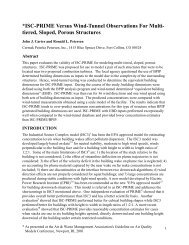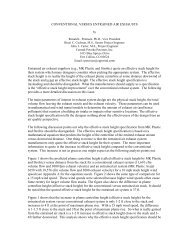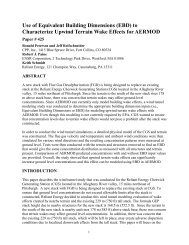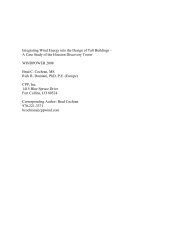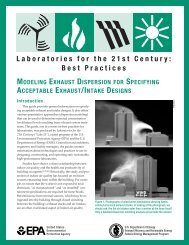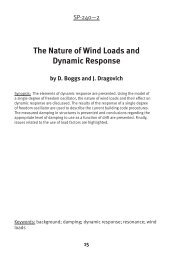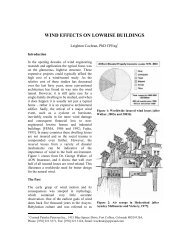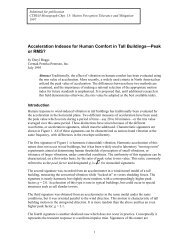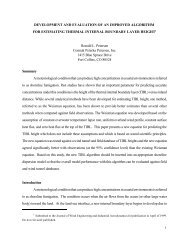Wind Load Analysis - CPP
Wind Load Analysis - CPP
Wind Load Analysis - CPP
You also want an ePaper? Increase the reach of your titles
YUMPU automatically turns print PDFs into web optimized ePapers that Google loves.
<strong>Wind</strong> <strong>Load</strong> <strong>Analysis</strong><br />
“Based on our testing and research, [treating arrays] as components and<br />
cladding on a monosloped roof provides a safe and generally conservative<br />
estimation of the actual loads on an array, particularly when one considers<br />
the loads over larger areas. However, when smaller tributary areas are<br />
considered, the code values appear to be less conservative and may, in<br />
certain cases, be unconservative.”<br />
—Gregory Kopp, Joe Maffei and Christopher Tilley, “Rooftop Solar Arrays and <strong>Wind</strong> <strong>Load</strong>ing”<br />
in ASCE 7-05 typically extend only 0.4h from the roof edges,<br />
while wind tunnel data suggests that the corner and roof<br />
zones should extend 2h from the roof edges.<br />
The effects of parapet walls on PV arrays are not characterized<br />
in ASCE 7-05 wind loads. While parapets reduce the<br />
peak wind loads at extreme corners and edges of the roof, they<br />
increase wind loads in interior areas. Modules that are very<br />
close to the parapet wall do receive some shielding benefit,<br />
provided that the parapet is close to or taller than the maximum<br />
height of the PV array.<br />
Objects on the roof that are taller than the PV array, such as<br />
penthouses and HVAC units, can also provide some shielding<br />
benefit; however, in certain wind directions,<br />
the objects can generate vortices<br />
that increase wind loads in the vicinity<br />
of the object. This possibility is not captured<br />
in the ASCE 7-05 standard.<br />
The alternative to complexity is to<br />
simplify the process by making conservative<br />
assumptions. However, making<br />
overconservative assumptions tends<br />
to drive up structural costs—perhaps<br />
making a viable project uneconomical—and<br />
may rule out other viable sites due to structural<br />
loading limitations.<br />
Recommended Practice for<br />
Estimating <strong>Wind</strong> <strong>Load</strong>s<br />
Capturing the effects of subarray spacing, parapets and<br />
rooftop objects in a recommended analytical process inherently<br />
forces the process to become more complicated than<br />
the typical application of ASCE 7-05. The other alternative<br />
is to simplify the process by making conservative assumptions.<br />
To avoid being overconservative, continued on page 86<br />
84 SolarPro | June/July 2012



